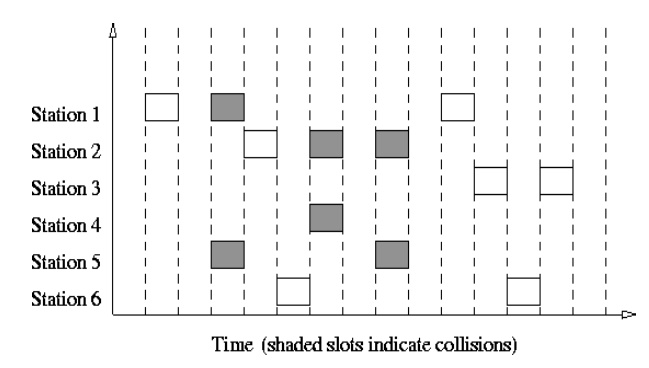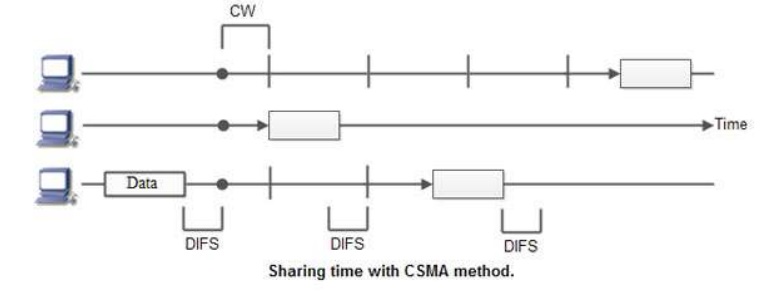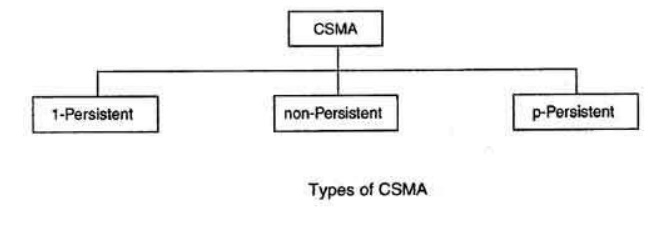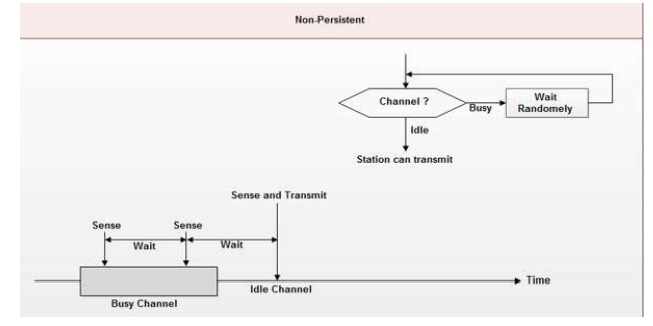Chapter: Mobile Computing
Random Assignment Schemes
RANDOM
ASSIGNMENT SCHEMES
Pure Aloha
With Pure Aloha, stations are allowed
access to the channel whenever they have data to transmit. Because the threat
of data collision exists, each station must either monitor its transmission on
the rebroadcast or await an acknowledgment from the destination station. By
comparing the transmitted packet with the received packet or by the lack of an
acknowledgement, the transmitting station can determine the success of the
transmitted packet. If the transmission was unsuccessful it is resent after a
random amount of time to reduce the probability of re-collision.

Slotted Aloha
The first of the contention based protocols we evaluate is the
Slotted Aloha protocol. The channel bandwidth is a continuous stream of slots
whose length is the time necessary to transmit one packet. A station with a
packet to send will transmit on the next available slot boundary. In the event
of a collision, each station involved in the collision retransmits at some
random time in order to reduce the possibility of recollision.
Obviously the limits imposed which govern the random
retransmission of the packet will have an effect on the delay associated with
successful packet delivery. If the limit is too short, the probability of
recollision is high. If the limit is too long the probability of recollision
lessens but there is unnecessary delay in the retransmission. For the Mars
regional network studied here, the resending of the packet will occur at some
random time not greater than the burst factor times the propagation delay.
Another important simulation characteristic of the Slotted Aloha
protocol is the action which takes place on transmission of the packet. Methods
include blocking (i.e. prohibiting packet generation) until verification of
successful transmission occurs. This is known as "stop-and-wait".
Another method known as "go-back-n" allows continual transmission of
queued packets, but on the detection of a collision, will retransmit all
packets from the point of the collision.
This is done to preserve the order of the packets. In this
simulation model queued packets are continually sent and only the packets
involved in a collision are retransmitted. This is called
"selective-repeat" and allows out of order transmission of packets.
By making a small restriction in the transmission freedom of the individual
stations, the throughput of the Aloha protocol can be doubled.
Assuming constant length packets, transmission time is broken
into slots equivalent to the transmission time of a single packet. Stations are
only allowed to transmit at slot boundaries. When packets collide they will
overlap completely instead of partially. This has the effect of doubling the
efficiency of the Aloha protocol and has come to be known as Slotted Aloha.

CSMA
CSMA is a
network access method used on shared network topologies such as Ethernet to
control access to the network. Devices attached to the network cable listen
(carrier sense) before transmitting. If the channel is in use, devices wait
before transmitting. MA (Multiple Access) indicates that many devices can
connect to and share the same network. All devices have equal access to use the
network when it is clear.
In other
words, a station that wants to communicate "listen" first on the
media communication and awaits a "silence" of a preset time (called
the Distributed Inter Frame Space or DIFS). After this compulsory period, the station
starts a countdown for a random period considered. The maximum duration of this
countdown is called the collision window (Window Collision, CW). If no
equipment speaks before the end of the countdown, the station simply deliver
its package. However, if it is overtaken by another station, it stops
immediately its countdown and waits for the next silence. She then continued
his account countdown where it left off.
The
waiting time random has the advantage of allowing a statistically equitable
distribution of speaking time between the various network equipment, while
making little unlikely (but not impossible) that both devices speak exactly the
same time. The countdown system prevents a station waiting too long before
issuing its package. It's a bit what place in a meeting room when no master
session (and all the World's polite) expected a silence, then a few moments
before speaking, to allow time for someone else to speak. The time is and
randomly assigned, that is to say, more or less equally.

Again,
this is what we do naturally in a meeting room if many people speak exactly the
same time, they are realizing account immediately (as they listen at the same
time they speak), and they interrupt without completing their sentence. After a
while, one of them speaks again. If a new collision occurs, the two are
interrupted again and tend to wait a little longer before speaking again.
CSMA
protocol was developed to overcome the problem found in ALOHA i.e. to minimize
the chances of collision, so as to improve the performance. CSMA protocol is
based on the principle of 'carrier sense'. The station senses the carrier or
channel before transmitting a frame. It means the station checks the state of
channel, whether it is idle or busy.
Even
though devices attempt to sense whether the network is in use, there is a good
chance that two stations will attempt to access it at the same time. On large
networks, the transmission time between one end of the cable and another is
enough that one station may access the cable even though another has already
just accessed it.
The
chances of collision still exist because of propagation delay. The frame
transmitted by one station takes some time to reach other stations. In the
meantime, other stations may sense the channel to be idle and transmit their
frames. This results in the collision.
There Are
Three Different Type of CSMA Protocols
(I)
I-persistent CSMA
(ii) Non- Persistent CSMA
(iii) p-persistent CSMA

(i) I-persistent CSMA
In this
method, station that wants to transmit data continuously senses the channel to
check whether the channel is idle or busy. If the channel is busy, the station
waits until it becomes idle. When the station detects an idle-channel, it
immediately transmits the frame with probability 1. Hence it is called
I-persistent CSMA. This method has the highest chance of collision because two
or more stations may find channel to be idle at the same time and transmit
their frames. When the collision occurs, the stations wait a random amount of
time and start all over again.
Drawback of I-persistent
The
propagation delay time greatly affects this protocol. If after the station I
begins its transmission, station 2 also became ready to send its data and
senses the channel. If the station I signal has not yet reached station 2,
station 2 will sense the channel to be idle and will begin its transmission.
This will result in collision.

Even if
propagation delay time is zero, collision will still occur. If two stations
became .ready in the middle of third
station's transmission, both stations will wait until the transmission of first
station ends and then both will begin their transmission exactly
simultaneously. This will also result in collision.
(ii) Non-persistent CSMA
In this
scheme, if a station wants to transmit a frame and it finds that the channel is
busy (some other station is transmitting) then it will wait for fixed interval
of time. After this time, it again checks the status of the channel and if the
channel is free it will transmit. A station that has a frame to send senses the
channel.
If the
channel is idle, it sends immediately. If the channel is busy, it waits a
random amount of time and then senses the channel again. In non-persistent CSMA
the station does not continuously sense the channel for the purpose of
capturing it when it detects the end of previous transmission.
Advantage of non-persistent
It
reduces the chance of collision because the stations wait a random amount of
time. It is unlikely that two or more stations will wait for same amount of
time and will retransmit at the same time.
Disadvantage of non-persistent
It reduces the efficiency of network because the
channel remains idle when there may be stations with frames to send. This is
due to the fact that the stations wait a random amount of time after the
collision.

(iii) p-persistent CSMA
This method is used when channel has time slots
such that the time slot duration is equal to or greater than the maximum
propagation delay time. Whenever a station becomes ready to send, it senses the
channel. If channel is busy, station waits until next slot. If channel is idle,
it transmits with a probability p.
With the probability q=l-p, the station then waits
for the beginning of the next time slot. If the next slot is also idle, it
either transmits or waits again with probabilities p and q. This process is
repeated till either frame has been transmitted or another station has begun
transmitting. In case of the transmission by another station, the station acts
as though collision
has
occurred and it waits a random amount of time and starts again.
Advantage of p-persistent
• It
reduces the chance of collision and improves the efficiency of the network.
Related Topics